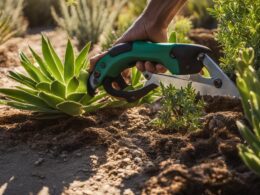Are you looking for effective strategies to maintain a lush landscape while conserving water? Look no further than xeriscape pest management. By combining various techniques, you can prevent and control pests in your xeriscape landscape while minimizing the impact on the environment and your health.
Key Takeaways:
- Xeriscape pest management offers effective solutions for conserving water and maintaining a lush landscape.
- Integrated Pest Management (IPM) combines physical, cultural, biological, and chemical techniques.
- Cultural control techniques, such as incorporating resistant varieties and native plants, help reduce pest problems.
- Mechanical and physical controls directly remove or kill pests and are compatible with biological controls.
- Biological control utilizes natural enemies to suppress or prevent pest outbreaks.
Cultural Control for Xeriscape Pest Management
In xeriscape pest management, cultural control techniques are a vital component for maintaining plant health and preventing pest problems. By incorporating resistant varieties, native plants, and well-adapted plants into your landscape, you can create a natural defense against pests. These plants are less susceptible to infestations and are better equipped to withstand environmental stresses.
Crop rotation and companion planting are effective practices for minimizing pest problems in xeriscape landscapes. Crop rotation involves changing the location of crops each year, disrupting pest life cycles and reducing the buildup of pests in the soil. Companion planting utilizes the natural interactions between different plant species to repel pests or attract beneficial insects that prey on pests.
Fertility management is another important aspect of cultural control. Properly managing the fertility of your soil can promote plant health and vigor, making plants more resilient to pests. By maintaining optimal levels of nutrients and organic matter in the soil, you can create conditions that discourage pest infestations.
Implementing these cultural control techniques in your xeriscape landscape can significantly contribute to pest prevention and plant health. By selecting the right plants, practicing crop rotation and companion planting, and effectively managing fertility, you can create a resilient and pest-resistant environment that thrives with minimal intervention.
Benefits of Cultural Control Techniques:
- Reduces the reliance on chemical pesticides
- Preserves the natural balance of the ecosystem
- Enhances plant health and resilience
- Minimizes the impact on human health and the environment
- Promotes sustainable and long-term pest management
“Cultural control techniques in xeriscape pest management are like building the foundation of a strong and healthy landscape. By selecting the right plants, implementing crop rotation and companion planting, and managing fertility, you establish a natural defense system that keeps pests at bay and promotes the overall health of your xeriscape.” – Xeriscape Expert
Xeriscape Mechanical and Physical Controls
To effectively manage pests in xeriscape landscapes, implementing mechanical and physical controls is essential. These strategies directly remove or kill pests, create barriers, and manipulate habitats to prevent infestations. By incorporating these techniques into your xeriscape pest management plan, you can maintain a healthy and thriving landscape without relying heavily on chemical pesticides.
Habitat Manipulation
Habitat manipulation is a powerful tool in xeriscape pest management. By altering the physical environment, you can make it less attractive and accommodating to pests. For example, removing debris and clutter can eliminate potential hiding spots for pests, while placing barriers like copper tape around vulnerable plants can deter slugs and snails. Creating a diverse and balanced ecosystem in your xeriscape landscape can also attract beneficial insects that prey on pests, helping to naturally control their populations.
Trapping Pests and Hand Removal
Incorporating trapping methods and hand removal techniques can physically eliminate pests from your xeriscape landscape. Traps can be strategically placed to capture pests like aphids or fruit flies, reducing their numbers. Hand removal involves manually picking off pests, such as caterpillars or beetles, and disposing of them. These methods are especially effective for localized infestations and can help prevent pest damage from spreading to other plants.
Mulching for Pest Control and Water Conservation
Mulching not only helps conserve water in xeriscape landscapes, but it also acts as a physical control against pests. Mulch creates a barrier between the soil and the air, preventing weed growth and reducing pest populations. Organic mulches, such as wood chips or straw, can also provide habitats for beneficial insects that feed on pests. Additionally, mulching helps regulate soil temperature, conserves moisture, and improves overall plant health, making it an invaluable practice in xeriscape pest management.
By incorporating mechanical and physical controls into your xeriscape pest management strategies, you can effectively reduce pest populations while maintaining a healthy and vibrant landscape. Habitat manipulation, trapping pests, and mulching are all valuable techniques that work in harmony with the principles of xeriscaping, allowing you to create a sustainable and environmentally friendly approach to pest control.
Xeriscape Biological Control: Harnessing Nature’s Defenders
When it comes to managing pests in xeriscape landscapes, harnessing the power of nature’s own defenders can be a sustainable and effective approach. Biological control, a key strategy in integrated pest management (IPM), relies on the use of natural enemies to suppress or prevent pest outbreaks. By attracting and protecting predators, parasitoids, and pathogens, xeriscape enthusiasts can maintain a healthy balance in their landscapes while reducing the need for chemical pesticides.
One of the main advantages of biological control is its low impact on the environment and non-target organisms. Predatory insects like ladybugs, lacewings, and spiders prey on common garden pests such as aphids, whiteflies, and mites. Parasitoids, on the other hand, lay their eggs inside pest insects, effectively killing them from within. Pathogens, including bacteria and fungi, can also be used to control specific pests. By incorporating conservation practices, such as reduced pesticide use and providing flowering plants for nectar and shelter, xeriscape landscapes can become havens for these natural enemies.
In addition to its environmental benefits, biological control offers long-term pest management solutions. While chemical pesticides provide immediate results, they often lead to resistance in pest populations and can harm beneficial insects. Biological control, on the other hand, is a sustainable approach that can be integrated into the overall ecosystem of a xeriscape landscape. By diversifying the habitat, fostering biodiversity, and reducing pest pressures through cultural and mechanical controls, xeriscape enthusiasts can create an environment where natural enemies thrive and keep pest populations in check.
Chemical Control in Xeriscape Pest Management
In xeriscape pest management, chemical control is considered a last resort but can be an effective tool when used responsibly. Responsible pesticide use is crucial to minimize the impact on non-target beneficial insects and the environment. By employing selective chemistries with a narrow host range, you can target specific pests while minimizing harm to beneficial organisms. Spot treatment, where only infested plants or stems are treated, can help reduce pesticide use.
Identifying the pest correctly is essential in chemical control. Treating only primary pests allows for a targeted approach and can help prevent unnecessary pesticide applications. It is important to wear personal protective gear, follow label instructions, and rely on chemical pesticides judiciously as a secondary option in an integrated approach to xeriscape pest management.
Key Points:
- Responsible pesticide use is vital in xeriscape pest management.
- Selective chemistries with a narrow host range can minimize harm to beneficial insects.
- Spot treatment reduces pesticide use by targeting only infested plants or stems.
- Proper identification of pests and treating only primary pests are essential in chemical control.
- Personal protective gear should be worn when handling chemical pesticides.
“Chemical control, although a last resort, can be a part of an effective xeriscape pest management program when used responsibly.”
By following these principles of responsible pesticide use, xeriscape enthusiasts can effectively manage pests while minimizing the negative impacts on the environment and human health. However, it is important to note that chemical control should always be integrated with other pest management strategies to achieve long-term and sustainable results in xeriscape landscapes.
Implementing Integrated Pest Management (IPM) in Xeriscape Landscapes
Implementing integrated pest management (IPM) in xeriscape landscapes is essential for effective pest control. By following the principles of IPM, you can prevent and manage pests while minimizing the impact on human health and the environment. It requires knowledge and understanding of plant and common pest problems, allowing you to take proactive measures to address them.
To successfully implement IPM in xeriscape landscapes, prevention is key. By focusing on stopping pests before they become a problem, you can avoid the need for extensive pest control measures. This includes selecting resistant plant varieties, practicing proper sanitation, and implementing cultural control techniques such as crop rotation and companion planting.
Regular monitoring is another crucial aspect of IPM in xeriscape landscapes. By regularly inspecting your plants for signs of pest activity, you can identify infestations early on and intervene before they spread. This allows you to use targeted management tools and minimize the use of chemical pesticides, reducing potential harm to the environment.
When implementing IPM, it’s important to utilize multiple management tools. This can include cultural practices, mechanical techniques, physical applications, biological controls, and, as a last resort, chemical applications. By diversifying your pest management strategies, you increase their effectiveness and reduce the risk of pests becoming resistant to any single method.
Evaluating the effectiveness of control measures and learning from the process is crucial in improving xeriscape pest management techniques. By assessing the success of your IPM program and making necessary adjustments, you can continually refine your approach and achieve thriving and pest-free xeriscape landscapes.
Key Points:
- Implementing IPM in xeriscape landscapes requires knowledge and understanding of plant and pest problems.
- Prevention is a critical aspect of IPM, focusing on stopping pests before they become a problem.
- Regular monitoring allows for early pest detection and targeted management.
- Utilizing multiple management tools, including cultural, mechanical, physical, biological, and chemical strategies, improves effectiveness.
- Evaluating and adjusting control measures help refine xeriscape pest management techniques.
What Are the Best Pest Management Strategies for Xeriscaping?
When creating a master xeriscape garden, pest management is crucial. Utilizing natural insect deterrent plants and practicing good soil health can help minimize pest issues. Implementing drip irrigation and employing mulch can also help keep pests at bay, promoting a thriving xeriscape garden.
The Importance of IPM in Various Settings
Integrated Pest Management (IPM) techniques are not limited to a single type of landscape. They can be applied in a variety of settings, including vegetable gardens, ornamental gardens, fruit trees, lawns, indoor spaces, schools, and public buildings. By implementing IPM strategies, you can effectively manage pests while minimizing the impact on the environment and human health.
In vegetable gardens, IPM practices such as regular monitoring, crop rotation, and the use of beneficial insects can help prevent pest infestations and ensure healthy, abundant harvests. Similarly, in ornamental gardens, IPM methods like proper plant selection, pruning, and maintaining soil health can keep pests at bay and create beautiful, thriving landscapes.
Fruit trees can benefit from IPM approaches such as pheromone traps, dormant oil applications, and the use of disease-resistant varieties. By implementing these practices, you can protect your fruit trees from pests and diseases, resulting in high-quality fruits.
IPM is also essential for maintaining pest-free lawns. By practicing cultural techniques like proper mowing heights, irrigation management, and soil testing, you can promote a healthy lawn that is less susceptible to pest damage. In indoor spaces, IPM focuses on preventing pests from entering buildings and using non-chemical methods, such as sealing entry points and implementing sanitation practices, to deter pests.
The importance of IPM extends beyond individual properties. In schools and public buildings, IPM is crucial for providing safe and healthy environments for students, employees, and visitors. By adopting IPM strategies, these institutions can effectively control pests while reducing the need for extensive pesticide use and minimizing risks to public health.
Conclusion
Xeriscape pest management strategies are essential for maintaining water conservation, creating lush landscapes, and achieving effective pest control. By implementing integrated pest management (IPM), you can combine a variety of techniques to prevent and control pests while minimizing the impact on the environment and human health.
IPM in xeriscape landscapes involves cultural, mechanical, physical, biological, and chemical approaches. Cultural controls, such as incorporating resistant and well-adapted plants, play a crucial role in maintaining plant health and reducing pest problems. Mechanical and physical controls, such as habitat manipulation and hand removal, directly eliminate pests and create barriers. Biological controls utilize natural enemies, like predators and parasitoids, to suppress pest outbreaks. Chemical controls, although a last resort, can be used judiciously and selectively, with proper identification and spot treatment techniques.
By applying these different pest management strategies and utilizing the principles of IPM, you can achieve thriving xeriscapes while minimizing the need for excessive pesticide use. With knowledge, prevention, regular monitoring, and the use of multiple control methods, you can create pest-free landscapes that are both sustainable and visually appealing.














